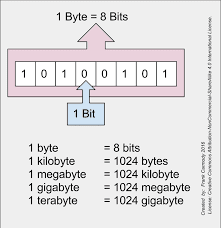ڈیٹا کی پیمائش کی اکائیاں
ڈیٹا کی پیمائش کی اکائیاں
بٹ (Bit) تمام کمپیوٹر ہندسوں کے ثنائی نظام کے تحت کام کرتے ہیں۔ وہ ایک یا صفر کی شکل میں ڈیٹا پراسیس کرتے ہیں۔ صفر اور ایک میں سے ہر ایک کو بٹ(Bit) کہاجاتا ہے۔ جو بائنری ڈجٹ (Binary digit) کے الفاظ سے اخذ کیاگیا ہے۔
بائٹ (Byte) آٹھ بیٹس(8 Bitss) پر مشتمل اکائی کو بائٹ کہتے ہیں۔اور بائٹ ایک کریکٹر یا حرف ہوتاہے۔
نبل (Nibble) چار بیٹس(4 Bitss) کی ترتیب یا سیکونس کو نبل کہتے ہیں۔
کلو بائٹ (Kilobyte) -: کمپیوٹر کی اصطلاح میں کلو سے مراد دو کی طاقت ( 210) یا 1024 ہے۔ ایک کلو بائٹ1024 بائٹس پر مشتمل ہوتا ہے۔
میگا بائٹ (Megabyte) ایک میگا بائٹ 10244 کلو بائٹس کے برابر ہو تا ہے۔
گیگا بائٹ-:(Gigabyte) ایک گیگا بائٹ 10244 میگا بائٹس کے برابر ہوتاہے۔ -:7 ٹیرا بائٹ-:(Tara byte) ایک ٹیرا بائٹ 1024 گیگا بائٹس کے برابر ہوتاہے۔
پیمائش کی ان اکائیوں کو ٹیبل کی صورت میں مختصر طور پر یوں بیان کیا جاسکتا ہے۔
آٹھ بِٹس (8 Bits ) = ایک بائٹ ( 1 Byte )
1024 بائٹس (1024 Bytes) = ایک کلو بائٹ (1 KB)
1024 کلو بائٹس (1024 KB ) = ایک میگا بائٹ ( 1 MB)
1024 میگا بائٹس (1024 MB ) = ایک گیگا بائٹ ( 1 GB )
1024 گیگا بائٹس (1024 GB ) = ایک ٹیر ا بائٹ ( 1 TB)
Units of measurement of data
Machine language is binary. And so it is necessary to discuss how to measure the data stored in a computer. Bit and Byte are the units to measure data.
Bit
The term ‘bit’ is a contraction of the words ‘binary’ and ‘digit’. It is the smallest unit of memory or instruction that can be given or stored on a computer. A bit is either a 0 or a 1. The number in the above example is a 6-bit number as it has 6 binary digits (0s and 1s).
Byte
A group of 8 bits like 01100001 is a byte. Combination of bytes comes with various names like the kilobyte. One kilobyte is a collection of 1000 bytes. A word or letter like ‘A’ or ‘G’ is worth 8 bits or one byte. One thousand bytes make up a kilobyte (one thousand letters approximately). 1024 kilobytes form a Megabyte (Mb) and so on.
Octal Number System (Base 8)
This system uses digits 0 to 7 (i.e. 8 digits) to represent a number and the numbers are as a base of 8.
For example, (24)8 in decimal is
= 2×81+4×80
= (20)10
Hexadecimal Number System (Base 16)
In this system, 16 digits used to represent a given number. Thus it is also known as the base 16 number system. Each digit position represents a power of 16. As the base is greater than 10, the number system is supplemented by letters. Following are the hexadecimal symbols: 0, 1, 2, 3, 4, 5, 6, 7, 8, 9, A, B, C, D, E, F
To take A, B, C, D, E, and F as part of the number system is conventional and has no logical or deductive reason.
Number System Chart
Name | Base | Symbols | Example |
| Decimal | 10 | 0,1,2,3,4,5,6,7,8,9 | (2795)10 |
| Binary | 2 | 0,1 | 111000010 |
| Octal | 8 | 0,1,2,3,4,5,6,7 | (1576)8 |
| Hexadecimal | 16 | 0,1,2,3,4,5,6,7,8,9,A,B,C,D,E,F | 3DB |

Comments
Post a Comment